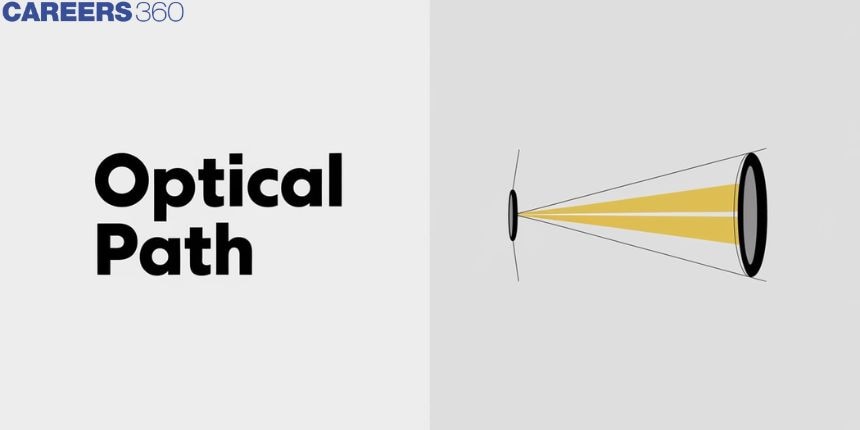Optical Path
The concept of the optical path is fundamental in understanding how light travels through various media, bending and changing speed along the way. In physics, the optical path length refers to the product of the physical distance light travels and the refractive index of the medium it traverses. This concept is crucial in optics, as it determines the phase of light waves and influences phenomena like interference and diffraction. Relating it to everyday life, consider how a straw appears bent when placed in a glass of water. This effect occurs because light travels at different speeds in air and water, changing its direction at the boundary. In this article, we will discuss the concept of optical path definition and different cases for it and provide examples for better understanding.
JEE Main/NEET 2027: Physics Important Formulas for Class 10
NEET 2025: Mock Test Series | Syllabus | High Scoring Topics | PYQs
JEE Main: Study Materials | High Scoring Topics | Preparation Guide
JEE Main: Syllabus | Sample Papers | Mock Tests | PYQs
- Optical Path
- Solved Example Based On Optical Path
- Summary

Optical Path
The optical path of light refers to the path taken by light as it travels through various media, influenced by the medium's refractive index. Unlike the physical distance, the optical path length takes into account how light slows down or speeds up as it passes through materials with different refractive properties. It is defined as the distance traveled by light in a vacuum, at the same time in which it travels a given path length in a medium.

Let light cover distance t in the medium having a refractive index as $\mu$ in Time T.
So $T=\frac{t}{v}$ where v=speed of light in the medium
and $\mu=\frac{c}{v}$ where c=speed of light in the vacuum.
So $T=\frac{t \mu}{c}$
So at the same time, the T distance covered by light in a vacuum is $l=c T=c * \frac{\mu t}{c}=\mu t$
So the relation between geometrical path (t) and optical path (l) is given as $l=\mu t$
For two mediums in contact as shown in the below figure

the optical path is equal to $\mu_1 x_1+\mu_2 x_2$
Change in the optical path in a transparent slab
Consider the following two cases
Case I- A light cover distance $l=AB$

So the optical path in this case is $L_1=l$
Case II- Now a slab of thickness t is placed between A and B

So distance travel in slab=t
and distance travel by air= $l-t$
So the optical path in this case is $L_2=(l-t)+\mu t$
Now change in the optical path = $\Delta x=L_2-L_1=[(l-t)+\mu t]-[l]=t(\mu-1)$
I.e due to the insertion of the slab the optical path is increased by $\Delta x=t(\mu-1)$
Recommended Topic Video
Solved Example Based On Optical Path
Example 1: Two light waves having the same wavelength $\lambda$ in vacuum are in phase initially. Then first ray travels a path of length $L_1$ through a medium of refractive index $\mu_1$. The second ray travels a path of length $L_2$ through refractive index $\mu_2$. The two waves are combined to observe the interference effect the phase difference between the two when they interfere is:
1) $\frac{2 \pi}{\lambda}\left(L_1-L_2\right)$
2) $\frac{2 \pi}{\lambda}\left(\mu_1 L_1-\mu_2 L_2\right)$
3) $\frac{2 \pi}{\lambda}\left(\mu_2 L_1-\mu_1 L_2\right)$
4) $\frac{2 \pi}{\lambda}\left(\frac{L_1}{\mu_1}-\frac{L_2}{\mu_2}\right)$
Solution:
Optical Path
$x^{\prime}=\mu \cdot x$
wherein
$x^{\prime}=$ Distance traveled in a vacuum
$x=$ Distance traveled in a medium of refractive index $\mu$
Optical path length $=\mu L$
Path difference $\Delta x=\mu_1 L_1-\mu_2 L_2$
Phase difference $\Delta \phi=\frac{2 \pi}{\lambda}\left(\mu_1 L_1-\mu_2 L_2\right)$
Hence, the answer is the option (2).
Example 2: The difference in the number of waves when yellow light propagates through air and vacuum columns of the same thickness is one. The thickness of the air column is ______ mm. [Refractive index of air $=1.0003$ wavelength of yellow light in vacuum $=6000 A^0$
1)2
2)4
3)1
4)6
Solution:

$
\begin{aligned}
& \lambda_{\text {air }}=\frac{\lambda_{\text {vacuum }}}{\mu_{\text {air }}} \\
& n_2-n_1=1
\end{aligned}
$
Let $n_1 \& n_2$ be the no. of waves in thickness t in vacuum \& air
$
\begin{aligned}
& n_1 \lambda_{\text {vaccum }}=n_2 \lambda_{\text {air }}=t \\
& n_1 \lambda_{\text {vaccum }}=\left(n_1+1\right) \times \frac{\lambda_{\text {vaccum }}}{\mu_{\text {air }}} \\
& \mu_{\text {air }}=1+\frac{1}{n_1} \\
& 1.0003=1+\frac{1}{n_1} \\
& 0.0003=\frac{1}{n_1} \\
& n_1=\frac{1}{3} \times 10^{+4} \\
& n_1 \lambda_{\text {vaccum }}=t \\
& \frac{1}{3} \times 10^4 \times 6000 \times 10^{-10}=t \\
& t=2 \mathrm{~mm}
\end{aligned}
$
Hence, the answer is the option (1).
Summary
The concept of optical path explores how light travels through various media, influenced by their refractive indices. It distinguishes between the physical distance and the optical path length, which considers the slowing or speeding of light in different materials. The article discusses the relationship between geometrical and optical paths, especially when transitioning between media, and demonstrates changes in optical paths using examples like a transparent slab. It also covers how these principles affect phase difference and interference in light waves.
Also Read
17 Nov'24 10:14 AM
26 Sep'24 11:26 AM
25 Sep'24 06:07 PM
25 Sep'24 05:38 PM
25 Sep'24 05:37 PM
25 Sep'24 05:37 PM
25 Sep'24 03:23 PM
25 Sep'24 03:22 PM
25 Sep'24 03:10 PM
25 Sep'24 03:09 PM